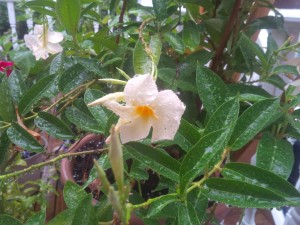 Back in 1837, when England’s Queen Victoria was a sweet young thing, new to the throne, and not even officially crowned, one of her diplomats sent a new plant back to England. The diplomat was Henry Mandeville, who was serving Her Majesty as Minister in Buenos Aires, Argentina. Mandeville, like so many of his globe-trotting contemporaries, was also an avid amateur botanist. When not conducting diplomacy, he conducted plant hunting forays. One of those resulted in the discovery of a vining plant with white, trumpet-shaped flowers. Originally given the rather non-harmonious genus name “Dipladenia”, the vine eventually acquired a name that honored its discoverer–Mandevilla laxa. Admirers sometimes call it “Chilean jasmine.”
Back in 1837, when England’s Queen Victoria was a sweet young thing, new to the throne, and not even officially crowned, one of her diplomats sent a new plant back to England. The diplomat was Henry Mandeville, who was serving Her Majesty as Minister in Buenos Aires, Argentina. Mandeville, like so many of his globe-trotting contemporaries, was also an avid amateur botanist. When not conducting diplomacy, he conducted plant hunting forays. One of those resulted in the discovery of a vining plant with white, trumpet-shaped flowers. Originally given the rather non-harmonious genus name “Dipladenia”, the vine eventually acquired a name that honored its discoverer–Mandevilla laxa. Admirers sometimes call it “Chilean jasmine.”
Chilean jasmine, which is native to Argentina and Bolivia, rather than Chile, caught on in England and elsewhere. It eventually became one of the parents of Mandevilla x amabilis, which is the mandevilla vine that many lucky gardeners now include in their container or in-ground planting schemes.
I am one of those lucky ones and recently became the proud possessor of a winsome, peach-colored mandevilla. It is currently presiding over a sunny spot on my back porch, blooming prolifically and inviting pollinators to its glowing, five-petaled trumpets.
“Amabilis” means “lovely”, which is a perfect description of my hybrid mandevilla and its close relatives. A healthy, mandevilla, its flexible stems trained on a trellis, tuteur or other sturdy support, can grow to ten feet tall and four feet wide. Those who are fearful of such dimensions should know that containerized specimens usually top out at about five feet.
Like many tropicals, it is an attractive foliage plant even when out of bloom. The abundant crinkled leaves are oblong and grow anywhere from three to eight inches long, making for an eye-catching display.
For years the most common hybrid mandevilla was the lovely ‘Alice Dupont’, a pink-flowered variety bred at Pennsylvania’s Longwood Gardens and named after the wife of its founder. But plant breeders are never happy with just one color, and over the course of the last couple of decades we have seen the introduction of vivid red mandevillas, not to mention plants with yellow, white, salmon and apricot blooms. Mine is one of the latter and the color bridges the gap between the bright shades of summer stalwarts like hibiscus and canna, and the more muted colors of the perennials that predominate in my garden.
If you look at them closely, mandevilla flowers are fascinating. The long, slender buds are furled, much like tightly rolled umbrellas. They open into deep-throated flowers, each of which lasts a few days before making a clean drop from the plant. The flower form is characteristic of the Apocynaceae or dogbane family. If you have Vinca minor, sometimes known as myrtle or periwinkle, growing in your garden, you will see the resemblance between mandevilla and vinca flowers. As is characteristic of dogbanes, mandevilla stems exude a milky sap, which can be irritating to the skin of some individuals.
The plants are fairly common and relatively inexpensive, so many gardeners treat them as annuals, trundling them to the curb or compost pile at the end of the growing season. This is not really necessary, though, if you have some sunny space indoors.
To overwinter a mandevilla, simply take the entire pot indoors when temperatures drop below 60 degrees Fahrenheit. Place it in a sunny spot and trim back, if necessary. From October through March, the mandevilla rests up for the next growing season, so water only when the top of the soil feels dry and don’t be offended when you see leaf drop and few signs of growth. At the end of March, begin watering more regularly and feed the plant with commercial plant food diluted according to package directions. When you and the mandevilla can be comfortable outside—as temperatures exceed 60 degrees–take the plant back to your porch, terrace or garden. The growth and bloom cycle will start all over again.
Mandevillas are very congenial garden performers, comfortable as single, specimen plants, but equally adept at sharing space in mixed borders. I have seen an array of eight or ten red-flowered plants trained along a black, wrought iron fence and the effect was glorious. For something a little different, try growing one in a large hanging basket with those long flower-laden stems trailing over the sides.
Now is a great time to pick up a mandevilla on sale. Check out the sale areas of local nurseries and garden centers for end-of-season bargains. We still have at least four or five weeks of outdoor display time and a whole season of dark days in which to contemplate how beautiful your bargain plants will be when clement weather rolls around again next spring.
